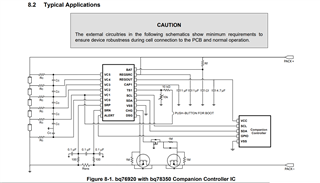Other Parts Discussed in Thread: BQ78350, BQ78350-R1, BQ76942
Hi all,
I am designing a BMS with the BQ76920.
I'll like to know the recommended wattage for Rsns and Rf in the typical application circuit shown below.

Regards,
Paul Nwoko.
This thread has been locked.
If you have a related question, please click the "Ask a related question" button in the top right corner. The newly created question will be automatically linked to this question.
Hi all,
I am designing a BMS with the BQ76920.
I'll like to know the recommended wattage for Rsns and Rf in the typical application circuit shown below.

Regards,
Paul Nwoko.
Hi Paul,
The EVM uses a 0.125W for Rf and a 2W for Rsns, however you should check to make sure that the sense resistor is correctly rated for your expected maximum system current as well as some extra tolerance.
Regards,
Max Verboncoeur
Hi Verboncoeur,
Thank you for your response.
I can't seem to find the EMV reference schematics for BQ76920.
Kindly share.
Regards,
Paul.
Hi Paul,
You can find the schematic at the end of the EVM User's Guide (link). You can also find the exact part numbers used in the BOM (also in the User's Guide).
Regards,
Max Verboncoeur
Thank you Verboncoeur.
How can I read the battery status without the bq78350 gauge chip? I'll like use as minimal component as possible.
Any portable Lib for that?
Regards.
Paul
Hi Paul,
I think that Question 1.2 of the FAQ document (link) for this device will help to answer your question.
You can use a microcontroller to interface with the device, and there is example code for the MSP430 available on the product page in the software development section.
Regards,
Max Verboncoeur
Hi Verboncoeur,
Thank you for your response. If I decide to use the bq76920 with a companion MCU (BQ78350DBTR-R1), can the MSP430 example code still be used to extract battery SOC info through the SMBUS of the companion MCU?
How much protection can the bq76920 provide without the companion MCU?
Which chip actually handles the balancing? The companion MCU or the bq76920?
Is there any chip that combines the BQ76920 and the companion MCU features together?
Regards,
Paul.
Hi Paul,
If I decide to use the bq76920 with a companion MCU (BQ78350DBTR-R1), can the MSP430 example code still be used to extract battery SOC info through the SMBUS of the companion MCU?
No, the MSP430 code will not work on the bq78350 companion gauge. The companion gauge's default flash memory includes all the required configurations for the bq76920. I recommend taking a look at the Using the bq78350-R1 application note for more details on its operation (link).
How much protection can the bq76920 provide without the companion MCU?
The bq76920 is not a standalone battery monitor. It requires a host controller to operate. The host controller is necessary for clearing faults and controlling cell balancing.
Which chip actually handles the balancing? The companion MCU or the bq76920?
The companion MCU completely controls the cell balancing.
Is there any chip that combines the BQ76920 and the companion MCU features together?
I recommend taking a look at the bq76942, which is an updated version of the bq769x0 family of devices that is able to operate as a standalone battery monitor (without a companion MCU).
Regards,
Max Verboncoeur
Thank you Verboncoeur.
"The companion MCU completely controls the cell balancing."
So when using the BQ76920 with it's companion MCU, from which interface should I read battery info (SOC etc) from? From the bq76920's I2C or the companion MCU's SMBus interface?
Thanks for the recommendation, will check it out.
Regards,
Paul.
HI Paul,
You should use the MCU's SMBus to read out data from the pack.
Regards,
Max Verboncoeur